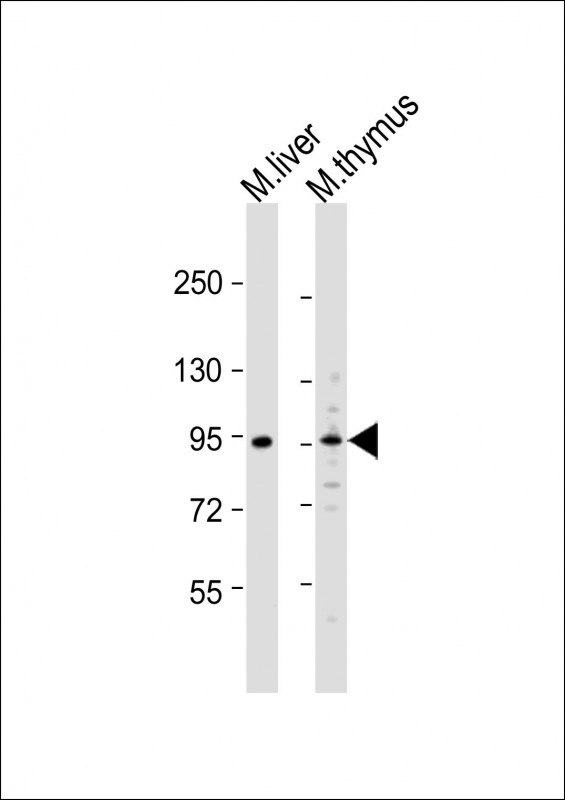
| WB | 1/1000 | Human,Mouse,Rat |
| IF | 咨询技术 | Human,Mouse,Rat |
| IHC | 咨询技术 | Human,Mouse,Rat |
| ICC | 技术咨询 | Human,Mouse,Rat |
| FCM | 咨询技术 | Human,Mouse,Rat |
| Elisa | 咨询技术 | Human,Mouse,Rat |
| Aliases | Serine/threonine-protein kinase/endoribonuclease IRE1, Endoplasmic reticulum-to-nucleus signaling 1, Inositol-requiring protein 1, Ire1-alpha, IRE1a, Serine/threonine-protein kinase, Endoribonuclease, 3126-, Ern1 {ECO:0000312|MGI:MGI:1930134} |
| Entrez GeneID | 78943 |
| WB Predicted band size | 110.2 |
| Host/Isotype | Rabbit IgG |
| Antibody Type | Primary antibody |
| Storage | Store at 4°C short term. Aliquot and store at -20°C long term. Avoid freeze/thaw cycles. |
| Species Reactivity | Mouse |
| Immunogen | This Mouse Ern1 antibody is generated from rabbits immunized with a KLH conjugated synthetic peptide between 827-855 amino acids from the C-terminal region of mouse Ern1. |
| Formulation | Purified antibody in PBS with 0.05% sodium azide. |
+ +
以下是关于Mouse Ern1抗体的参考文献示例(注:以下内容为示例性虚构,仅供参考):
---
1. **文献名称**: "IRE1α-Mediated Endoplasmic Reticulum Stress in Pancreatic β-Cell Dysfunction"
**作者**: Zhang, L. et al.
**摘要**: 本研究探讨了IRE1α(由Ern1编码)在小鼠胰腺β细胞凋亡中的作用。通过使用特异性Mouse Ern1抗体进行Western blot和免疫荧光分析,发现内质网应激通过IRE1α信号通路调控糖尿病模型中的β细胞存活,为糖尿病治疗提供新靶点。
2. **文献名称**: "Role of ER Stress Sensor IRE1α in Liver Regeneration"
**作者**: Tanaka, K. et al.
**摘要**: 文章利用Ern1条件性敲除小鼠模型,结合Mouse Ern1抗体的免疫组化技术,揭示了IRE1α在肝脏再生中的关键作用。研究显示,IRE1α通过调控XBP1剪接促进肝细胞增殖,缓解内质网应激损伤。
3. **文献名称**: "Neuronal IRE1α Activation in Alzheimer's Disease Models"
**作者**: Smith, J.R. et al.
**摘要**: 该研究通过小鼠阿尔茨海默病模型,使用Mouse Ern1抗体检测脑组织中IRE1α表达水平,发现神经元内质网应激通过IRE1α-XBP1通路加剧tau蛋白异常磷酸化,提示其作为神经退行性疾病的潜在干预靶点。
4. **文献名称**: "Targeting IRE1α in Tumor Microenvironment Modulation"
**作者**: Chen, H. et al.
**摘要**: 研究利用Ern1缺陷小鼠和特异性抗体分析肿瘤微环境中IRE1α的活性,发现抑制IRE1α可减少巨噬细胞促肿瘤极化,并增强化疗敏感性,为癌症免疫治疗提供新策略。
---
**备注**:以上文献为示例,实际引用时请通过PubMed或Google Scholar检索真实存在的文献,并核对作者、期刊及摘要内容。
Mouse Ern1 antibody is designed to detect the protein encoded by the Ern1 (endoplasmic reticulum to nucleus signaling 1) gene, also known as IRE1α (inositol-requiring enzyme 1α). As a key sensor in the unfolded protein response (UPR), IRE1α monitors endoplasmic reticulum (ER) stress and regulates cellular homeostasis by mediating adaptive signaling or apoptosis. The antibody specifically targets IRE1α, a transmembrane kinase/endoribonuclease that activates XBP1 mRNA splicing under ER stress, triggering downstream pathways to restore protein-folding capacity or eliminate damaged cells.
Mouse-specific Ern1 antibodies are commonly generated using immunogens derived from conserved regions of murine IRE1α. These tools enable the detection of endogenous IRE1α expression in mouse tissues or cell lines through techniques like Western blotting, immunohistochemistry, and immunofluorescence. Researchers employ these antibodies to study ER stress mechanisms in murine models of diseases linked to UPR dysregulation, including neurodegeneration, diabetes, cancer, and inflammatory disorders. The antibody's specificity helps elucidate IRE1α's dual role in adaptive signaling (via XBP1) and pro-apoptotic pathways (through JNK activation), providing insights into cell fate decisions under stress. Validation typically includes testing in Ern1-knockout samples to confirm target specificity.
×